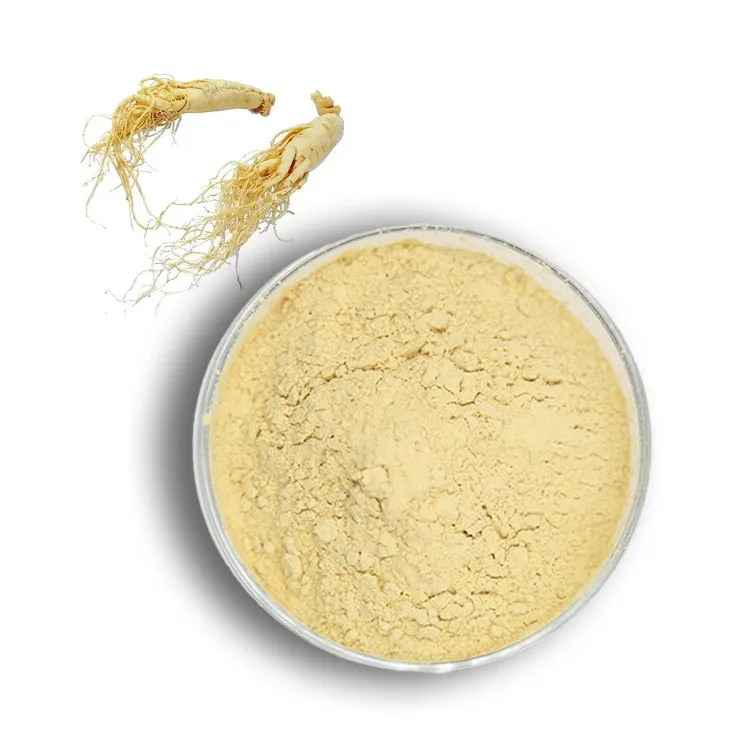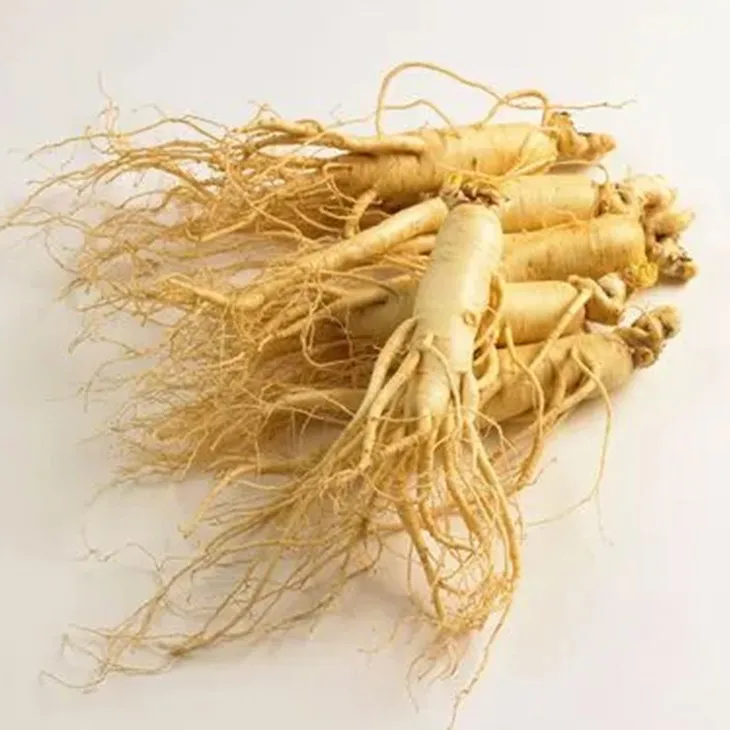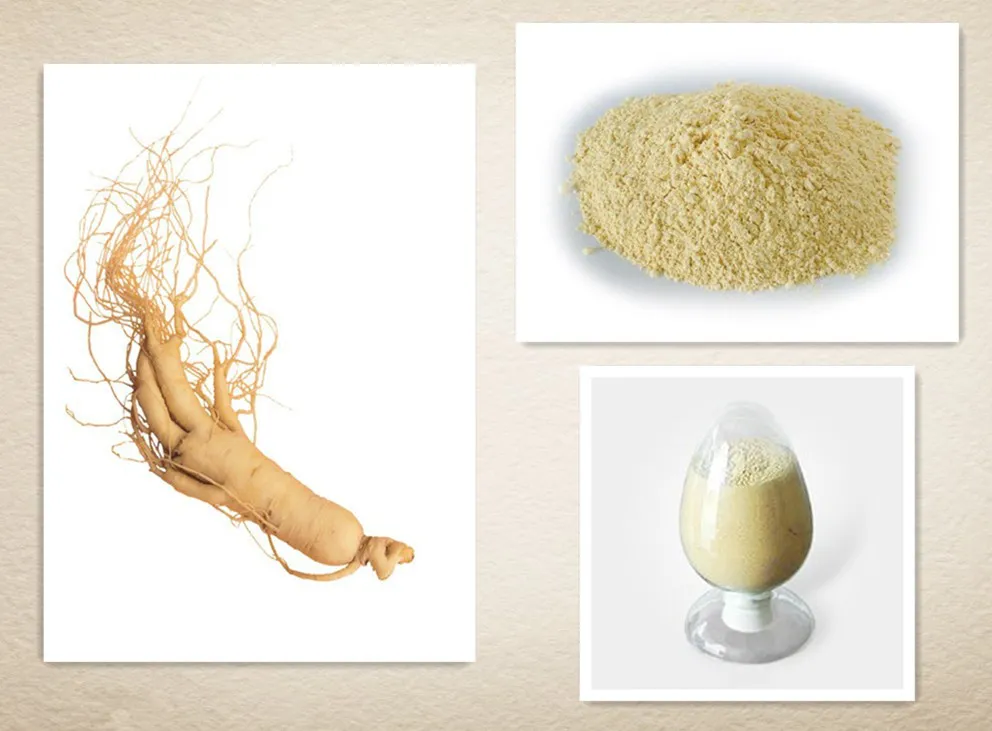- 0086-571-85302990
- sales@greenskybio.com
The flavor of mature ginseng roots and natural ginseng root extracts.
2024-11-13

1. Introduction
Ginseng, a renowned herb in traditional medicine, has been highly valued for centuries. Mature ginseng roots and their extracts play significant roles not only in the field of health but also in the beauty industry. Understanding the flavor of mature ginseng roots and the value of natural Ginseng Root Extracts is essential for a comprehensive appreciation of this precious plant.

2. Cultivation and its influence on the flavor of mature ginseng roots
2.1 Soil conditions
The soil in which ginseng is cultivated has a profound impact on the flavor of its roots. Ginseng prefers well - drained, rich in organic matter soils. For example, in some regions with loamy soil, the ginseng roots tend to develop a more complex and earthy flavor. The minerals present in the soil, such as potassium, phosphorus, and calcium, are absorbed by the ginseng plants, contributing to the unique taste. Soil acidity also plays a role. A slightly acidic soil may enhance the development of certain flavor compounds in the roots.
2.2 Climate factors
Climate is another crucial factor. Ginseng grows well in cool and humid climates. In areas with distinct seasons, the growth cycle of ginseng is regulated by temperature changes. Cold winters and mild summers can influence the accumulation of metabolites in the roots. The cold temperature may slow down the plant's metabolism, allowing for a more concentrated flavor development. Moreover, the amount of rainfall and humidity levels affect the plant's water uptake and transpiration, which in turn can modify the flavor profile. For instance, in regions with higher humidity, the ginseng roots may have a moister and more mellow flavor.
2.3 Growth period
The longer the growth period of ginseng, the more developed its flavor becomes. Mature ginseng that has been growing for several years (usually 4 - 6 years or more) will have a more intense and distinct flavor compared to younger plants. During the growth process, the roots gradually accumulate various substances, such as saponins, polysaccharides, and volatile compounds, which are responsible for the characteristic flavor.

3. Formation of the flavor of mature ginseng roots
3.1 Chemical compounds
- Saponins are one of the main components contributing to the flavor of ginseng roots. These glycosides have a bitter and slightly sweet taste. Different types of saponins, such as ginsenosides, are present in varying amounts in mature ginseng roots, creating a complex flavor profile.
- Polysaccharides also play a role. They give a certain thickness and mild sweetness to the flavor. These complex carbohydrates are important for the overall taste and mouthfeel of ginseng products.
- Volatile compounds, including terpenes and esters, are responsible for the aromatic aspect of the ginseng root flavor. They give off a characteristic earthy, woody, and slightly spicy smell, which adds to the overall flavor experience when consumed.
3.2 Interaction of compounds
The various chemical compounds in ginseng roots do not act independently. Instead, they interact with each other to create the final flavor. For example, the bitterness of saponins can be balanced by the sweetness of polysaccharides. The volatile compounds interact with the non - volatile ones, enhancing the overall aroma and taste perception. This complex interaction is what makes the flavor of mature ginseng roots so unique and difficult to replicate synthetically.

4. Extraction methods of natural Ginseng Root Extracts
4.1 Solvent extraction
- One common method is solvent extraction. Ethanol is often used as a solvent. The process involves soaking the ginseng roots in ethanol to dissolve the active compounds. This method is relatively simple and can extract a wide range of substances, including saponins, polysaccharides, and some volatile compounds. However, it requires careful control of parameters such as solvent concentration, extraction time, and temperature to ensure the quality of the extract.
- Another solvent that can be used is water. Water extraction is a more natural and environmentally friendly option. It is suitable for extracting water - soluble compounds such as polysaccharides. However, water extraction may not be as effective in extracting some lipophilic compounds compared to ethanol extraction.
4.2 Supercritical fluid extraction
Supercritical fluid extraction, typically using carbon dioxide as the supercritical fluid, has emerged as a more advanced extraction method. This method has several advantages. Firstly, it can operate at relatively low temperatures, which helps to preserve the integrity of the active compounds in ginseng roots. Secondly, the selectivity of the extraction can be adjusted by changing the pressure and temperature conditions. This allows for a more targeted extraction of specific compounds. However, the equipment for supercritical fluid extraction is more expensive and requires more technical expertise to operate.
4.3 Microwave - assisted extraction
Microwave - assisted extraction is a relatively new technique. It utilizes microwave energy to accelerate the extraction process. The microwaves heat the solvent and the ginseng root material, increasing the mass transfer rate of the active compounds from the roots to the solvent. This method can significantly reduce the extraction time compared to traditional solvent extraction methods. However, it also requires careful optimization of microwave power and extraction time to avoid over - extraction or degradation of the active compounds.

5. Value of natural Ginseng Root Extracts in the health industry
5.1 Adaptogenic properties
Natural ginseng root extracts are known for their adaptogenic properties. They can help the body adapt to various stressors, whether physical or mental. The saponins in the extract are believed to play a key role in this regard. For example, in a study, participants who consumed ginseng root extracts showed improved resistance to fatigue and better stress management. This adaptogenic effect can be beneficial for people with high - stress lifestyles or those recovering from illness.
5.2 Immune - boosting effects
- The polysaccharides present in ginseng root extracts have been shown to have immune - boosting effects. They can stimulate the activity of immune cells such as macrophages and lymphocytes.
- In some clinical trials, patients who took ginseng root extracts had a reduced incidence of infections, suggesting that the extracts can enhance the body's immune defense mechanism.
5.3 Anti - inflammatory properties
Some components in ginseng root extracts, such as certain saponins, have anti - inflammatory properties. They can inhibit the production of inflammatory mediators in the body. This makes ginseng root extracts potentially useful in the treatment of inflammatory diseases such as arthritis. Research has shown that ginseng root extracts can reduce inflammation - related pain and swelling in animal models.

6. Value of natural ginseng root extracts in the beauty industry
6.1 Anti - aging effects
- The antioxidants present in ginseng root extracts, such as polyphenols, can combat free radicals in the skin. Free radicals are known to cause oxidative stress, which leads to premature aging of the skin.
- Ginseng root extracts can also stimulate collagen production in the skin. Collagen is essential for maintaining skin elasticity and firmness. By promoting collagen synthesis, the extracts can help reduce the appearance of wrinkles and fine lines.
6.2 Skin - brightening effects
Some compounds in ginseng root extracts have been reported to have skin - brightening effects. They can inhibit the production of melanin in the skin, which is responsible for skin pigmentation. This makes ginseng root extracts a potential ingredient in skin - lightening products for treating hyperpigmentation problems such as dark spots and melasma.
6.3 Hair - growth promoting effects
- Ginseng root extracts can improve blood circulation in the scalp. Good blood circulation is necessary for delivering nutrients to the hair follicles.
- Some studies suggest that the extracts can also stimulate hair follicle cells, promoting hair growth and preventing hair loss.
7. Conclusion
In conclusion, the flavor of mature ginseng roots is a complex result of cultivation conditions and the interaction of various chemical compounds. The extraction methods of natural ginseng root extracts are diverse, each with its own advantages and limitations. The value of these extracts in the health and beauty industries is significant, due to their numerous beneficial properties. As research continues, we can expect to gain even more in - depth understanding of ginseng and its potential applications, further unlocking the secrets of this remarkable plant.
FAQ:
Q1: How is the flavor of mature ginseng roots formed?
The flavor of mature ginseng roots is formed through a combination of factors. Firstly, during the growth process, the soil composition in which ginseng is cultivated plays a crucial role. Ginseng thrives in well - drained, nutrient - rich soil, and the minerals and organic matter in the soil can influence the flavor. Secondly, the long - term growth and development over several years allow the ginseng roots to accumulate various chemical compounds. These include ginsenosides, which are a major group of active ingredients and contribute to the unique flavor. Additionally, environmental factors such as sunlight, temperature, and humidity during the growth period also have an impact on the formation of the flavor.
Q2: What are the main extraction methods for natural ginseng root extracts?
There are several common extraction methods for natural ginseng root extracts. One of the most traditional methods is water extraction. In this process, ginseng roots are soaked in water and then heated gently to allow the active ingredients to dissolve into the water. Another method is alcohol extraction. Ethanol or other alcohols are used as solvents to extract the bioactive components from the ginseng roots. This method is often more effective in extracting certain lipophilic compounds. Additionally, modern extraction techniques such as supercritical fluid extraction are also being explored. Supercritical carbon dioxide is used as a solvent under specific pressure and temperature conditions to obtain high - quality ginseng root extracts with relatively pure components and less solvent residue.
Q3: Why are natural ginseng root extracts so valuable in the health industry?
Natural ginseng root extracts are highly valuable in the health industry for multiple reasons. The ginsenosides present in the extracts have been shown to have various beneficial effects on human health. For example, they can enhance the immune system, helping the body to better resist diseases. Ginseng extracts also have adaptogenic properties, which means they can help the body adapt to stress, both physical and mental. Moreover, some studies suggest that they may have anti - inflammatory and antioxidant effects, which are beneficial for preventing chronic diseases and promoting overall well - being. Additionally, ginseng has a long history of use in traditional medicine, which adds to its credibility and value in the modern health industry.
Q4: How are natural ginseng root extracts used in the beauty industry?
In the beauty industry, natural ginseng root extracts are used in a variety of ways. They are often added to skincare products such as creams, lotions, and serums. The antioxidant properties of ginseng extracts can help to protect the skin from free - radical damage, which is associated with premature aging. Ginseng extracts also have the potential to improve skin elasticity and firmness. This is because they can stimulate collagen production in the skin. Additionally, some products use ginseng extracts for their anti - inflammatory properties, which can be beneficial for reducing skin redness and irritation, especially for those with sensitive skin.
Q5: What are the differences in the flavor of ginseng roots from different cultivation areas?
The flavor of ginseng roots can vary significantly depending on the cultivation area. Ginseng grown in different regions may have different soil types, climates, and altitudes. For example, ginseng cultivated in mountainous areas may have a more intense and complex flavor compared to those grown in flatter regions. The soil in mountainous areas may be richer in certain minerals, which can influence the flavor. Also, the temperature and humidity variations in different regions can lead to differences in the growth rate and chemical composition of ginseng roots. In colder regions, ginseng may grow more slowly, resulting in a more concentrated flavor, while in warmer areas, the growth may be faster, but the flavor may be relatively milder.
Related literature
- The Composition and Properties of Ginseng Root Extracts"
- "Cultivation of Ginseng: Impact on Root Quality and Flavor"
- "The Role of Ginseng in Health and Beauty: A Comprehensive Review"
- "Extraction Techniques for Ginseng: Optimizing the Yield of Bioactive Compounds"
- ▶ Hesperidin
- ▶ citrus bioflavonoids
- ▶ plant extract
- ▶ lycopene
- ▶ Diosmin
- ▶ Grape seed extract
- ▶ Sea buckthorn Juice Powder
- ▶ Beetroot powder
- ▶ Hops Extract
- ▶ Artichoke Extract
- ▶ Reishi mushroom extract
- ▶ Astaxanthin
- ▶ Green Tea Extract
- ▶ Curcumin Extract
- ▶ Horse Chestnut Extract
- ▶ Other Problems
- ▶ Boswellia Serrata Extract
- ▶ Resveratrol Extract
- ▶ Marigold Extract
- ▶ Grape Leaf Extract
- ▶ blog3
- ▶ blog4
- ▶ blog5
-
Organic Tongkat Ali extract powder factory.
2024-11-13
-
How to make powder with ashwagandha extract.
2024-11-13
-
Rosehip extract manufacturers from China.
2024-11-13
-
The best cat's claw extract in nature.
2024-11-13
-
Chinese Dandelion Leaf Extract Suppliers.
2024-11-13
-
Medicinal Marshmallow Extract
2024-11-13
-
Hericium erinaceus extract powder
2024-11-13
-
Lotus leaf extract
2024-11-13
-
Hops Extract
2024-11-13
-
Aguaje Extract
2024-11-13
-
Kelp Extract Powder
2024-11-13
-
Grapefruit Seed Extract Powder
2024-11-13
-
Sophora Japonica Flower Extract
2024-11-13
-
Polygonum multiflorum extract
2024-11-13
-
Polygonum Cuspidatum Extract
2024-11-13





















